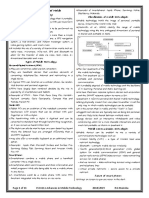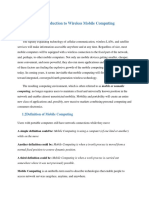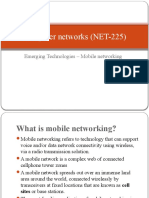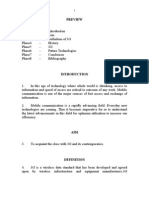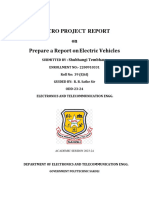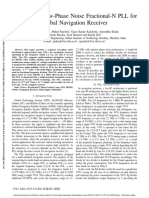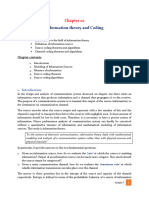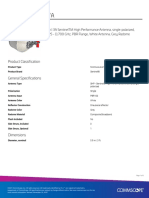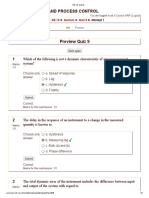INFORMATION TECHNOLOGY
MOBILE NETWORKS
HANDOUT
What is a Mobile Network?
Mobile networking also known as cellular networks refers to technology that can
support voice and/or data network connectivity using wireless, via a radio transmission
solution. They are made up of “cells” that connect to one another and to telephone
switches or exchanges. The most familiar application of mobile networking is the mobile
phone. In the past, wireless communications predominantly used circuit switching to
carry voice over a network; however, more recently both voice and data are being
transmitted over both circuit-switched and packet-switched networks.
Generation of Mobile Networks
First Generation (1G) 1981 – NMT (Nordic Mobile Telephone) launch
The first mobile systems were based on analog transmission. They had a low traffic
density of one call per radio channel (only allow calls in one country), poor voice quality
as it had a maximum capacity of 2kbps, and they used insecure and unencrypted
transmission, which led to the spoofing of identities (spoofing is pretending to be
someone else).
Second Generation (2G) 1991 – GSM launch
1 | Page
�The second generation of mobile systems was based on digital transmission with several
different standards including GSM. 2G was the technology that ultimately allowed data
services such as SMS and MMS to become prolific on mobile phones later in the decade.
It only has a maximum speed of 50 kilobits per second.
Second to Third Generation Bridge (2.5G) 2000 – GPRS launch
The introduction of GPRS is seen as an extra period of mobile networking development,
between 2G and 3G. GPRS (General Packet Radio Service) is a data service, which
enables mobile devices to send and receive e-mails and picture messages. It allows very
popular operating speeds of up to 115kbit/s, which has been increased to a maximum of
384kbit/s by using EDGE (Enhanced Data rates for Global Evolution.
Third Generation (3G) 2003 – First UK 3G launch
The third generation of mobile systems unifies different mobile technology standards
and uses higher frequency bands for transmission and Code Division Multiple Access to
deliver data rates of up to 2Mbit/s to support multimedia services (MMS: voice, video
and data). This generation saw the introduction of broadband internet access to mobile
phones.
Fourth Generation (4G) 2007+
4G technology is qualified with higher data rate, spectral efficiency, security,
intelligence, flexibility, higher transmission quality and service quality. LTE is a 4G
technology developed for GSM Network and it is the first 4G Technology used in mobile
phones across the world. It is a high-speed data transferor for mobile phones with
299.6 Mbps (Megabits per Second) download speed and 75.4 Mbps up load speed.
Suitability of Mobile Networks to various Applications
Airlines - Various airlines now allow passengers to access their boarding passes as two-
dimensional bar codes that can be displayed on their smart phones and scanned at
boarding gates and security checkpoints.
Automotive – Some companies such as Autonet Mobile offers a device that turns a car
into a Wi-Fi hotspot. On the horizon are cell phones that start the car or adjust the seats.
Banking - Bigger screens and better browsers are driving millions of smart phone users
to online banking. What’s more, banks report the first wave of mobile users have higher
rates of customer satisfaction and are more likely to provide referrals than traditional
customers. Online banking adds convenience without asking people to spend money by
incurring bank charges inside the bank.
Education – cell phones have been used in schools to help improve student’s math skills
by using smart phones to solve real-world applications of math concepts presented
partly in videos and other multimedia formats. Teachers can utilize the use of cell
phones for playing educational games, brainstorming by getting students input via their
cell phones etc. Many schools still see cell phones as a distraction to students but now,
teachers are realizing that while not every student has a laptop, every student is mobile,
so you need to go where they already are.
2 | Page
�Energy – many homes are now equipped with smart meters, providing utilities and
homeowners with greater ability to control energy usage and costs.
Healthcare – used by doctors to look up a patient’s medical record or for drug
references.
Hotels - many hotels such as Marriott International has seen increase in revenue after
introducing mobile web bookings. The on-the-go bookings were particularly appealing
to travelers. Cell phones are also used to send specials and coupons to hotel guests via
text messages.
Publishing – e-books have become very popular especially through mobile networks. In
Japan, half of the top 10 best-selling books in 2007 were eBooks. With the introduction
of devices like Kindle2, the American book industry is set for a new era of digital, mobile
readers.
Journalism - mobile reporting is defined as generating reports using mobile phone
cameras and digital cameras. Most of the mobile reports are citizens generated.
Whenever an incident happens, citizens capture live and send it to reporting authorities
or share it on social media. Social media i.e. Twitter and Facebook are the most common
and largest means of spreading any news or incident. Before the advent of these
platforms, only radio and news channels were the basic source of incident reporting.
Nowadays, more content related to any incident can be found on internet rather than TV
channels and radio channels. Mobile technology has changed broadcast journalism
rapidly.
3 | Page



